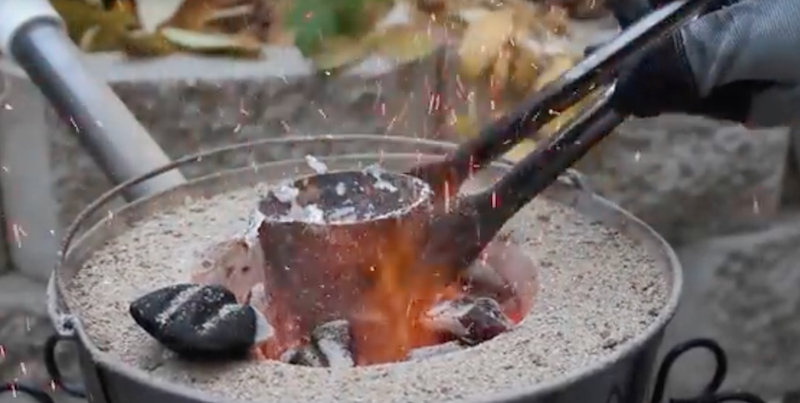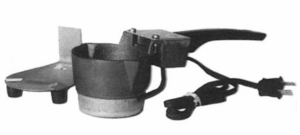Backyard Metal Foundry Dreams

Sometimes my brain works in unexpected ways. I haven’t started any new electronics projects lately, but my thoughts have been spinning in other directions.
Last weekend I jokingly told my kids that I was starting a home-based ore smelting business. Because today’s busy families just don’t have time to process their bauxite, taconite, and other ores at home, the way Grandma used to. Keeping up with the household’s demand for antimony and zinc can be such a chore – but now there’s a better way! My friendly staff will pick up your ore, lovingly smelt it, dispose of the slag responsibly, and return the processed metal in 100g nuggets stamped with your choice of fun logo designs. Naturally, this ore smelting business will be named He Who Smelt It Dealt It.
Three things I learned from this groan-worthy joke:
- It’s taconite, not taco night
- I’ve been pronouncing the word antimony (an·tuh·mow·nee) wrong for my entire life
- Melting converts a solid into a liquid. Smelting converts ore to its purest form.
Yet somehow this smelting comedy gradually transformed from a bad joke into a semi-serious idea for a fun backyard project. Actual smelting probably isn’t a great plan, because where the heck would I find ore? And do I really want to process large piles of messy rocks to extract a bit of tin? Instead of smelting, I soon found myself researching designs for a backyard metal foundry.
I was fascinated. This Mini Metal Foundry design looks simple to build and operate, but can easily reach temperatures of 660 C (1221F) – hot enough to melt aluminum, zinc, lead, tin, and pewter. The molten metal can then be poured into steel molds or sand cast to make tools, toys, and trinkets. Sure the quality won’t be great, but if you perked up at hearing the words “molten metal”, then I like your thinking and we should hang out sometime. Check out this video:
Of course I immediately began planning for my backyard metal foundry. My wife, however, was considerably less enthusiastic about my prospects for doing this without making the neighbors call the fire department or outright killing myself. She has an advanced degree in materials science, and actually has real lab experience working with large pools of molten lead, germanium, and other metals, so she probably knows what she’s talking about. I began to pay more attention once I learned about what happens if there’s a metal spill onto outdoor concrete. Moisture held in the concrete can instantly flash into steam, shooting globs of molten metal in all directions at high speed. See the example at time index 7:35 in the video. It looks horrific. So I’ll hold my backyard foundry plans in the “maybe” category for now.
Enter plan B, an inexpensive 500 Watt electric ladle. Designed for small metal casting projects, this little gem can’t melt aluminum, but it’s still hot enough to melt lead and maybe zinc (though I’m not sure exactly what I’d do with molten zinc). For about $50, it could be the perfect tool for DIY-enthusiasts who want to melt some metals without burning down the house.

A few metals that might pair nicely with this tool, ordered by melting point:
zinc (maybe) – 419C, 787F – The tool says it’ll melt lead, but the melting point of zinc is not too much higher. What can you do with zinc? I’ve heard of zinc plating, but don’t think I’ve ever seen a solid zinc object.
lead – 327C, 621F – Lead has a bad reputation these days, but how great is the risk assuming you’re not eating the stuff? Maybe it’s best to avoid it anyway.
pewter – 295C, 563F – In my mind, pewter is what 18th century candlesticks are made from. It’s an alloy of tin, antimony, and copper. It’s also sometimes used for jewelry and can be polished to a shiny finish.
bismuth – 271C, 521F – I have no mental concept of bismuth except as an ingredient of Pepto-Bismol. What does metallic bismuth look like? Is it safe to handle? Is it ever used for metal casting?
babbitt – 249C, 480F – I’m including babbitt on this list because I’d never even heard of it until yesterday. I learned that babbitt is an alloy of tin, lead, copper, and antimony, and is commonly used for making low-friction bearings.
tin – 232C, 449F – In years past, tin was popular for making cups and dishes. It should be cheap and safe, but maybe not very exciting. At this melting point, I wouldn’t even need any special heating tools: I could just melt tin ingots in steel molds with my kitchen oven.
solder – 183C, 361F – Solder wouldn’t normally be used for casting, but why not? Probably because it’s too easily bendable, and there are better alternatives. Lead-free solder has a higher melting point of 217C/422F, but it’s still lower than any other metal on this list.
Why do all the metals with low melting points have a silver/gray color? It would be nice to have more variety. To find a metal that’s a difficult color, I believe you have to climb the temperature scale to about 890C/1630F to melt brass and bronze. Copper and gold have melting points that are even higher. If I were a super chemist, I’d probably have some explanation why metal colors are related to their melting points.
Have you ever experimented with metal casting for making jewelry or tools? Ever built a backyard foundry and melted some aluminum soda cans? Leave a note in the comments and tell us your story.
Read 13 comments and join the conversation
13 Comments so far
Leave a reply. For customer support issues, please use the Customer Support link instead of writing comments.


DON’T BREATHE ZINC FUMES! Unless you enjoy spending time in the hospital.
Seriously. Don’t even weld galvanized steel without precautions.
I made the small foundry from the king of random video. The only time I tried to use it was on a cold winter day and I lost feeling in my fingers before I got the aluminum cans to melt. I think I wasn’t getting enough air into the foundry to keep the temperatures up. Since then, I’ve had it in my garage and I occasionally get excited about using it again but haven’t found the time. I will use it someday!
Dillon, you’re my hero! Give that foundry another try and post some videos. What type of charcoal did you use? In one of KoR’s follow-up videos, he said that lump charcoal will burn much hotter than the regular charcoal used for grilling burgers, although both should work.
I definitely used the grilling variety. It’s starting to get into the freeze-my-fingers season, but maybe I can get fire it up before it gets too cold.
US Cents (pennies) made from 1983 to present are 97.5% zinc with a plating of copper. Not sure what the laws are about melting them down though, assuming you could get past the copper shell with a higher melting point. Then of course there’s Ken’s comment about not breathing the fumes…
An excellent Youtube channel for this is myfordboy https://www.youtube.com/channel/UCNC9gjgYrzLfyMQmp31DnjA
Covers melting metal (he uses used motor oil for fuel) and lots of information on sand molding. Old alloy car wheels are his favourite source of metal.
And while I’m on fantastic metal related YouTube — watch clickspring if you aren’t already.
https://www.youtube.com/channel/UCworsKCR-Sx6R6-BnIjS2MA
Alas I have not done any backyard foundry work 🙁
I’ve been building small foundries since I was about 14. Forced air charcoal systems have been around for a few thousand years for a good reason, they are simple to build and effective. I cast a reasonable amount of aluminium with a furnace itself cast out of portland cement and perlite cat litter. As a 14 year old pouring molten metal I made some discoveries including that when the top layer of your skin flash boils the Leidenfrost effect can save you from more serious burns, and the nerve endings die so quickly you don’t even feel a few drips of aluminium. Thankfully I’m not left with any scars from that experience. These setups really are dangerous but you can mitigate most all of the potential disasters with just a little forward thinking and an understanding of the modes of failure, which it sounds like you have.
Right now for some tiny parts I’ve been using a 250w soldering pot similar to the ladle you linked. They are a great way to learn how to make molds which is where all the skill is anyway.
A few things to remember. Pouring a casting is quite exciting which can understandably make you want to rush but everything including your casting will work out better if you work in a controlled metered way. Oh and yes be really careful about the fumes. There are a bunch of neurological and lung conditions you can give yourself if you aren’t careful about exactly what you are melting.
RE: “ don’t think I’ve ever seen a solid zinc object”
Sacrificial anodes are usually solid cast zinc objects… when dis-similar metals are immersed in saltwater, an electrical current is generated which begins to eat away at the softer of the metals involved. I see them often in/on boats in the marine environment to prevent such electrolysis. Boat zincs are often cast into bars, fish, streamlined half-teardrops, and “eggs” cut in half and channeled out to bolt onto the propeller shaft.
Also, depending on the water system in your area, and the design of your domestic hot water system, you may have a few solid zinc rods electrically grounded inside your hot water heater.
Coming from the Pacific NorthWest, casting zinc is probably one of the few remaining practical overlaps in old and new technology.
I did it, Steve. I melted some cans in the foundry yesterday. I pulled it out without much preparation but found that the most important thing was a good seal between the forces air coming in and the furnace. Before it was very leaky and wasn’t very efficient. Once it was getting a ton of air I melted a dozen or so cans. I really wasn’t prepared so I’m going to start hoarding cans again and come up with an idea on how to use the resulting aluminum block.
Awesome, nice work! Photos are mandatory.
Not very impressive, but here’s the slug. I’ll have to take photos of the setup next time I use it. https://photos.app.goo.gl/PjangFP8rVPihnwi9
I mucked around with charcoal furnaces when I was a teenager. I built a few with my brother, starting with an old coffee tin and working up to a steel bucket lined with a concrete/clay mix. The important part is getting air in, we used a variety of fans and old vacuum cleaners to blast air in via a plenum underneath. My coal was to cast some copper but we only had success with aluminium. There’s also this metal you find in cheap castings like lawnmower decks, called pig metal. It has zinc and aluminium so it has a relatively low melting point but it’s more usable than pure zinc. Zinc is safe to melt, you just have to keep the temperature below its boiling point (900C). Once it boils you get nasty fumes and this fluffy stuff called philosopher’s wool. Lead’s fun to melt and easy to cast. It’s pretty safe to handle just don’t go licking your fingers. We used to throw old batteries on a fire and collect a slab of lead from the ashes once it cooled enough.
Build yourself a furnace it’s fun. Like anything, use a bit of common sense and you won’t get hurt.
Here’s my first real object: https://twitter.com/dillon1337/status/1283856026274537482?s=21